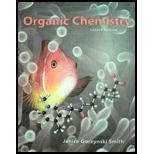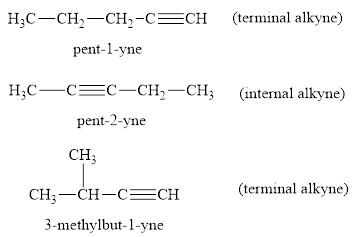
Concept explainers
Draw structures for the three
Interpretation: The three alkynes having molecular formula C5H8 is to be drawn and each is to be classified as an internal or terminal alkyne.
Concept Introduction: Alkynes are an unsaturated hydrocarbon having at least one carbon-carbon triple bond. The general formula of alkynes are CnH2n-2. The simplest hydrocarbon of alkyne family is acetylene having two carbon atom. Alkynes can be divided into the following two categories based on the position of triple bond; 1) internal alkyne 2) terminal alkyne. In internal alkynes there are no hydrogen atoms bonded to triply bonded carbon atoms. In terminal alkynes there is at least one hydrogen atom bonded to a triply bonded carbon atom.
Answer to Problem 11.1P
the internal and terminal alkynes of molecular formula C5H8 are as follows;

Explanation of Solution
In pent-1-yne and 3-methyl but-1-yne the triple bond is at the terminal side of carbon having one -C-H group. Thus, they are called as terminal alkynes. In case of pent-2-yne the triple bond is in the middle of carbon having no free -C-H group. Thus, it is called as internal alkyne.
Thus, the alkynes of formula C5H is drawn and named as an internal alkyne or terminal alkyne.
Want to see more full solutions like this?
Chapter 11 Solutions
Organic Chemistry - With Access (Custom)
 ChemistryChemistryISBN:9781305957404Author:Steven S. Zumdahl, Susan A. Zumdahl, Donald J. DeCostePublisher:Cengage Learning
ChemistryChemistryISBN:9781305957404Author:Steven S. Zumdahl, Susan A. Zumdahl, Donald J. DeCostePublisher:Cengage Learning ChemistryChemistryISBN:9781259911156Author:Raymond Chang Dr., Jason Overby ProfessorPublisher:McGraw-Hill Education
ChemistryChemistryISBN:9781259911156Author:Raymond Chang Dr., Jason Overby ProfessorPublisher:McGraw-Hill Education Principles of Instrumental AnalysisChemistryISBN:9781305577213Author:Douglas A. Skoog, F. James Holler, Stanley R. CrouchPublisher:Cengage Learning
Principles of Instrumental AnalysisChemistryISBN:9781305577213Author:Douglas A. Skoog, F. James Holler, Stanley R. CrouchPublisher:Cengage Learning Organic ChemistryChemistryISBN:9780078021558Author:Janice Gorzynski Smith Dr.Publisher:McGraw-Hill Education
Organic ChemistryChemistryISBN:9780078021558Author:Janice Gorzynski Smith Dr.Publisher:McGraw-Hill Education Chemistry: Principles and ReactionsChemistryISBN:9781305079373Author:William L. Masterton, Cecile N. HurleyPublisher:Cengage Learning
Chemistry: Principles and ReactionsChemistryISBN:9781305079373Author:William L. Masterton, Cecile N. HurleyPublisher:Cengage Learning Elementary Principles of Chemical Processes, Bind...ChemistryISBN:9781118431221Author:Richard M. Felder, Ronald W. Rousseau, Lisa G. BullardPublisher:WILEY
Elementary Principles of Chemical Processes, Bind...ChemistryISBN:9781118431221Author:Richard M. Felder, Ronald W. Rousseau, Lisa G. BullardPublisher:WILEY





